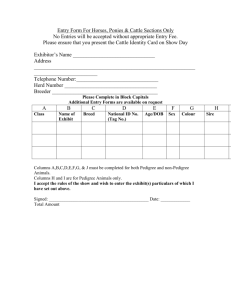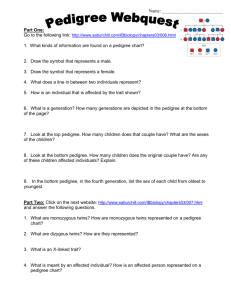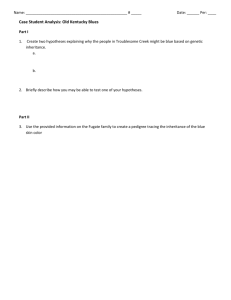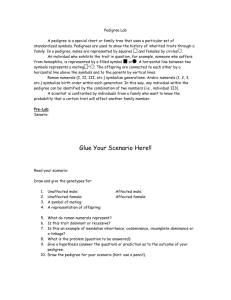Name_______________________________________
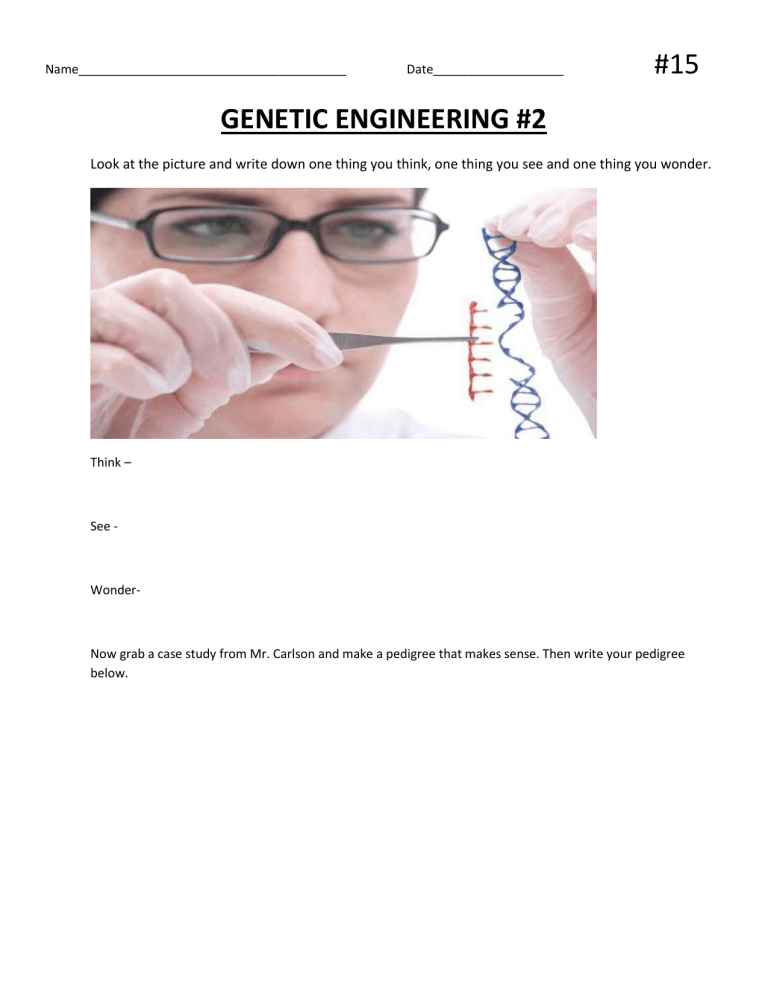
Name_______________________________________ Date___________________
#15
GENETIC ENGINEERING #2
Look at the picture and write down one thing you think, one thing you see and one thing you wonder.
Think –
See -
Wonder-
Now grab a case study from Mr. Carlson and make a pedigree that makes sense. Then write your pedigree below.
Now watch the video on your phone and answer the questions that are in the video. Put your answers to the questions below.
Go to educanon. com and sign in and then find the teacher code 6c6df. Watch the video on Genetic Engineering.
Answers:
1) 2) 3) 4)
Now go to the lab tables in the back and look at the pedigree chart of Hemophilia in European Royal
Families. Also look at the back of the worksheet and see how Hemophilia is inherited. Then answer these questions.
1) What are the names of the males who were hemophiliacs in the Royal Family?
2) What were the names of the females who were hemophiliacs? (Trick question)
3) What is the genotype of being a male?
4) What is the genotype of being a female?
5) Why is hemophilia considered a sex linked gene?
6) Why do males only receive hemophilia when it is considered an X-linked recessive disorder?
Fill in the blanks using the word bank:
Human Cloning? Stem Cell Advance Reignites Ethics Debate
Stephanie Pappas, LiveScience Senior Writer | May 17, 2013 06:11pm ET
A new stem cell discovery has reawakened controversy about human cloning
— though technical challenges mean scientists are far from being able to create human babies as in Michael Bay's 2005 sci-fi flick "The
Island." Not that they would even want to.
"Nobody in their right mind would want to do that," said John Gearhart, the director of the Institute for
Regenerative Medicine at the University of Pennsylvania, who was not involved in the study. And indeed, the research wasn't conducted with the idea of creating cloned mini-me's in mind. Instead, scientists attempting to treat diseases of the cell's powerhouse, the mitochondria, refined the technique, which is the same one used to create the cloned sheep Dolly in 1996.
But the parallels between the animal-cloning procedure and the new human one have triggered concern. The
U.S. Conference of Catholic Bishops (USCCB) swiftly issued a statement condemning the research, both on the grounds that embryos were destroyed in the research process and over the concern that the full reproductive cloning of humans is on its way.
"They or others may be close to being able to develop cloned human embryos to the fetal stage and then beyond," said Richard Doerflinger, the associate director of USCCB's Secretariat of Pro-Life Activities.
Technical difficulties
Fortunately for anyone concerned about the specter of human cloning, scientists say they're nowhere close to being able to get cloned human embryos past early stages of development. The study's leader , Shoukhrat
Mitalipov of Oregon Health & Science University, told reporters that the early embryos — 100-cell bundles known as blastocysts — seem to have defects preventing them from implanting properly in the uterus and reaching maturity.
A blastocyst consists of an inner mass of cells that will become the fetus. Surrounding this inner cell mass as a hollow ball is a layer of cells called the trophoblast. These trophoblast cells are destined to become the placenta, the organ that nourishes the growing embryo and, later, the fetus.
Give your opinion below on what you think about this article and what it says:
PEDIGREE CASE STUDY 1
Margaret has just learned that she has adult polycystic kidney disease. Her mother also has the disease, as did her maternal grandfather and his younger brother (both of whom are now dead). As far as Margaret knows, no one else in her extended family has the disease, although she had a sister, Allison, who died in a car accident when she was 16 and might have showed symptoms if she had lived long enough.
Margaret is 42 years old and has three children, Anna (20), Lydia (18), and Tom (15). Her husband’s name is Art.
Draw a pedigree for this family, using the proper symbols.
PEDIGREE CASE STUDY 2
Grant had a younger sister, Nanna, who died of cystic fibrosis when she was 22. He is 28 now, has recently gotten married to a woman named Claire, and wants to start a family. However, Claire knows she is a carrier for CF because her two older brothers, who were identical twins, died of it several years ago and she decided to get tested for the disease allele. No one else in Grant’s or Claire’s family has ever gotten the illness. Grant’s and Caire’s parents are still living and are healthy.
Draw a pedigree for this family, using the proper symbols.
PEDIGREE CASE STUDY 3
Luisa and Mario both come from large families and want to have a large family of their own. However, Mario has a rare genetic condition called congenital hypertrichosis, a disease he shares with his mother and his younger sister.
Hypertrichosis is dominant and is caused by a mutation in a gene on the X chromosome.
If Mario and Luisa have eight children, 3 boys and 5 girls, draw a pedigree for this family, using the proper symbols.


